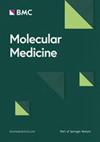NAT10-mediated ac4C acetylation of TFRC promotes sepsis-induced pulmonary injury through regulating ferroptosis
IF 6
2区 医学
Q1 BIOCHEMISTRY & MOLECULAR BIOLOGY
引用次数: 0
Abstract
Sepsis-induced pulmonary injury (SPI) is a common complication of sepsis with a high rate of mortality. N4-acetylcytidine (ac4C) is mediated by the ac4C “writer”, N-acetyltransferase (NAT)10, to regulate the stabilization of mRNA. This study aimed to investigate the role of NAT10 in SPI and the underlying mechanism. Twenty-three acute respiratory distress syndrome (ARDS) patients and 27 non-ARDS volunteers were recruited. A sepsis rat model was established. Reverse transcription-quantitative polymerase chain reaction was used to detect the expression of NAT10 and transferrin receptor (TFRC). Cell viability was detected by cell counting kit-8. The levels of Fe2+, glutathione, and malondialdehyde were assessed by commercial kits. Lipid reactive oxygen species production was measured by flow cytometric analysis. Western blot was used to detect ferroptosis-related protein levels. Haematoxylin & eosin staining was performed to observe the pulmonary pathological symptoms. The results showed that NAT10 was increased in ARDS patients and lipopolysaccharide-treated human lung microvascular endothelial cell line-5a (HULEC-5a) cells. NAT10 inhibition increased cell viability and decreased ferroptosis in HULEC-5a cells. TFRC was a downstream regulatory target of NAT10-mediated ac4C acetylation. Overexpression of TFRC decreased cell viability and promoted ferroptosis. In in vivo study, NAT10 inhibition alleviated SPI. NAT10-mediated ac4C acetylation of TFRC aggravated SPI through promoting ferroptosis.NAT10 介导的 TFRC ac4C 乙酰化通过调节铁蛋白沉积促进脓毒症诱发的肺损伤
败血症诱发的肺损伤(SPI)是败血症的一种常见并发症,死亡率很高。N4-乙酰胞苷(ac4C)由ac4C "作家 "N-乙酰转移酶(NAT)10介导,调节mRNA的稳定。本研究旨在探讨 NAT10 在 SPI 中的作用及其内在机制。研究人员招募了 23 名急性呼吸窘迫综合征(ARDS)患者和 27 名非 ARDS 志愿者。建立了败血症大鼠模型。采用逆转录-定量聚合酶链反应检测 NAT10 和转铁蛋白受体(TFRC)的表达。用细胞计数试剂盒-8检测细胞活力。Fe2+、谷胱甘肽和丙二醛的水平由商用试剂盒进行评估。脂质活性氧的产生是通过流式细胞分析测定的。Western 印迹法用于检测铁变态反应相关蛋白质的水平。采用血红素和伊红染色法观察肺部病理症状。结果显示,NAT10在ARDS患者和脂多糖处理的人肺微血管内皮细胞系-5a(HULEC-5a)细胞中增加。抑制NAT10可提高HULEC-5a细胞的存活率并降低其铁蛋白沉积。TFRC是NAT10介导的ac4C乙酰化的下游调控靶标。过表达 TFRC 会降低细胞活力并促进铁凋亡。在体内研究中,抑制 NAT10 可减轻 SPI。NAT10介导的TFRC的ac4C乙酰化通过促进铁变态反应加重了SPI。
本文章由计算机程序翻译,如有差异,请以英文原文为准。
求助全文
约1分钟内获得全文
求助全文
来源期刊

Molecular Medicine
医学-生化与分子生物学
CiteScore
8.60
自引率
0.00%
发文量
137
审稿时长
1 months
期刊介绍:
Molecular Medicine is an open access journal that focuses on publishing recent findings related to disease pathogenesis at the molecular or physiological level. These insights can potentially contribute to the development of specific tools for disease diagnosis, treatment, or prevention. The journal considers manuscripts that present material pertinent to the genetic, molecular, or cellular underpinnings of critical physiological or disease processes. Submissions to Molecular Medicine are expected to elucidate the broader implications of the research findings for human disease and medicine in a manner that is accessible to a wide audience.
 求助内容:
求助内容: 应助结果提醒方式:
应助结果提醒方式:


